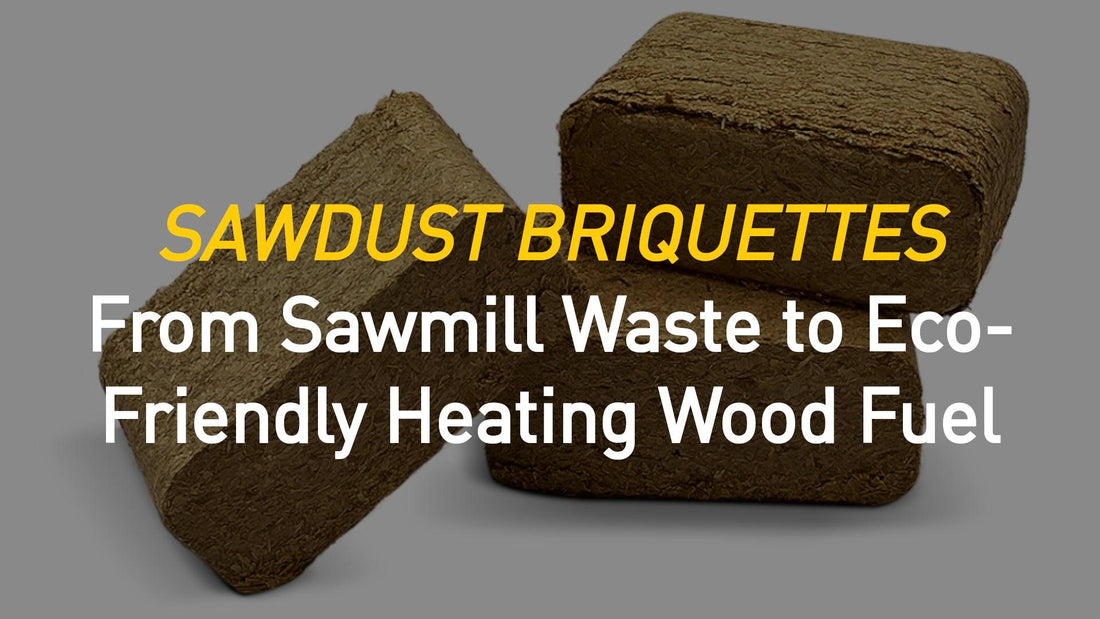
Sawdust Briquettes Are Saving the Planet: See Their Journey From Recycled Wood to Fuel
With climate change becoming a real threat, the entire world is rethinking its approach to sustainability and care for the environment. Being a responsible and eco-conscious nation, the UK has been at the forefront of this change.
As a result, many households have begun rethinking the way they heat their homes. Those relying on fire heat are beginning to eschew harmful and polluting coal in favour of renewable wood fuels. And those already using firewood logs for their heating are showing an increased interest in wood briquettes made from recycled sawmill waste.
The most popular type of wood briquette on the UK market is the humble sawdust briquette.
Having been a staple of British households since the nineteenth century, sawdust briquettes are a reliable, easy-to-use time-tested fuel that has helped countless households save money on wood heating over the years. The peaks of their popularity came during World War II and various oil crises as more traditional heating fuel was either unavailable or too expensive to purchase.
And now they’re making a massive comeback for both environmental and economic reasons.
In this article, we’ll tell you how sawdust briquettes are made and what makes them much more eco-friendly than traditional firewood.
Read Also:
Can Bark Briquettes Really Burn 4X Longer Than Conventional Briquettes?
The Top 5 Signs of a Quality Firewood Log Supplier
Unpacking the UK's Upcoming House Coal Ban: Fines, Exemptions, and Alternatives
What Are Sawdust Briquettes?
Sawdust briquettes, also called RUF briquettes, are a type of solid wood fuel produced from recycled hardwood sawdust (most often birch). They have been a sought-after choice for those looking to save money on heating thanks to their high heat output, long burn time, and eco-friendly composition.
One of the standout features of all wood briquettes is their extremely low moisture content. While firewood is typically dried to under 20% moisture, as is required by the Ready to Burn standard, whereas wood briquettes are porous and can easily be dried to under 9% moisture. This allows briquettes to burn cleaner and much more efficiently than even the most premium firewood logs.
Sawdust Briquette Technical Information
Lekto’s Sawdust briquettes have a high calorific value of 5,100 Wh per kilogramme. This helps them burn hotter and longer than conventional firewood. Their compact size and convenient, stackable boxes also make them easy to store. This is especially important for households with minimal storage space.
Sawdust briquettes have a very low ash content of just 0.3%, which is great news for people who don’t want to deal with excessive wood stove cleanup after use.
And as they are made from waste materials, using sawdust briquettes as your primary fuel source reduces waste and can significantly reduce your household’s environmental footprint. If it weren’t turned into a heading briquette, the sawdust would either end up in a landfill immediately or be turned into furniture (and end up in that same landfill after a decade or so).
How Are Sawdust Briquettes Made?
So, how exactly is this environmentally friendly wood fuel produced?
It all begins with raw, unprocessed hardwood sawdust. A natural byproduct of the forestry and sawmill industries, it can be purchased rather inexpensively. The sawmill industry is highly seasonal, so hardwood sawdust can only be purchased during the summer months.
The raw sawdust is then dried to reduce its moisture content. This step is needed to help it burn cleanly and ensure maximum heat output. As sawdust has a large surface area, it can be dried far more efficiently than regular firewood.
Once the sawdust is sufficiently dry, it is compressed under high pressure by an industrial pressing rod to form a brick-shaped briquette. The resulting product has a far higher density than conventional firewood. This helps briquettes achieve their signature high energy density.
No glues or other binding agents need to be added during the compression process as sawdust contains lignin, which turns into a natural binder when subjected to high pressure.
The History of Sawdust Briquettes
The history of briquettes traces back to 1865 when the first modern briquetting machine was invented. That machine was used to create an inexpensive briquette fuel from peat moss. The design proved incredibly popular in Ireland, where peat briquettes are widely used to this day. Peat briquettes produce a strong odour when burned that some people like and other people don’t.
Eventually, the design was improved and it became possible to create briquettes out of sawdust. This was a major breakthrough as sawdust is a cleaner-burning material that does not produce an odour when burned.
Over the years, improvements in briquetting technology have made the process a lot more efficient. Modern briquettes can be compacted to a far higher density than earlier versions. They also burn cleaner and aren’t as prone to breaking.
Read our Ultimate Guide to Briquettes to learn more.
Why Choose Sawdust Briquettes?
Apart from their unquestionable ecological benefits, sawdust briquettes also offer several practical advantages when compared to regular birch or oak firewood. Their high heat output and long burning time make them an efficient choice for heating as you need to burn a lower volume of wood fuel to get the same amount of heat. Additionally, their uniform shape and compact size made them a lot easier to handle and store.
As there are no splinters to worry about, they can be safely handled even by small children.
And, of course, using sawdust briquettes helps contribute to waste reduction by giving a new life to sawmill byproducts, which would otherwise end up in a landfill.
Sawdust Briquettes Shopping Guide
When shopping for sawdust briquettes, look for products that are:
- Ready to Burn certified.
- Have a high calorific value (over 4.5 kWh/kg).
- Have a low moisture content (under 9% is ideal)
- Sustainably sourced.
- Sold by a brand you can trust.
- Have plenty of real customer reviews praising their high quality.
Lekto’s Sawdust Briquettes pass all these tests with flying colours. Visit their store page to find out more or read real customer reviews about them on Lekto’s Trustpilot page.
Frequently Asked Questions About Sawdust Briquettes
What are sawdust briquettes?
Sawdust briquettes, also known as RUF briquettes, are a type of solid fuel produced by compressing dry recycled sawdust into a high-density brick.
How are sawdust briquettes made?
Sawdust briquettes are made by compressing sawdust under high pressure and high temperature until they form a dense, solid, brick-shaped unit. The lignin in the wood acts as a natural adhesive, binding the particles together, so no chemical binders need to be used.
What Is the UK Government Doing to Fight Pollution?
The government has recently enacted a series of environmental policies aimed at achieving carbon neutrality. While most of these were aimed at industry, there was one type of change that affected UK households directly. This was the ban on heating fuels that were deemed to be harmful to the environment.
In February 2021, the UK government banned the sale of all wet wood in the UK. From that point onward, all logs and briquettes sold in the UK needed to contain no more than 20% moisture. This was enforced via the Ready to Burn wood fuel quality standard. And on May 1, 2023, the government banned the sale of house coal and introduced a separate Ready to Burn standard for coal.
What is the calorific value of sawdust briquettes?
The calorific value of sawdust briquettes is typically around 5 kWh/kg, which makes them an efficient fuel source for heating.
Are sawdust briquettes environmentally friendly?
Yes, when compared to regular firewood logs, sawdust briquettes are considered an eco-friendly fuel source. They are made from waste materials and produce fewer emissions compared to traditional fossil fuels.
Can I use sawdust briquettes in my wood-burning stove?
Yes, sawdust briquettes can be used in virtually any wood-burning stove and open fire. They burn hotter and longer than traditional logs, making them an efficient and eco-friendly choice.
How do sawdust briquettes compare to traditional logs in terms of burn time?
Thanks to their ultra-high energy density, sawdust briquettes tend to burn for a significantly longer time than traditional logs due to their low moisture content and high density.
How should I store sawdust briquettes?
Sawdust briquettes should be stored in a dry location to prevent them from absorbing moisture. If at all possible, avoid taking them out of their protective packaging until you need them. Once they’re taken out of their protective packaging, they need to be stored in a dry, well-ventilated place.
Why should I switch to sawdust briquettes?
If you’re a user of kiln-dried logs, then switching to sawdust briquettes is a cost-effective and eco-friendly decision. They provide a higher heat output and a longer burn time than any firewood logs. They’re more compact and easy to store. They also help reduce the need for traditional wood logging, contributing to forest conservation efforts.
